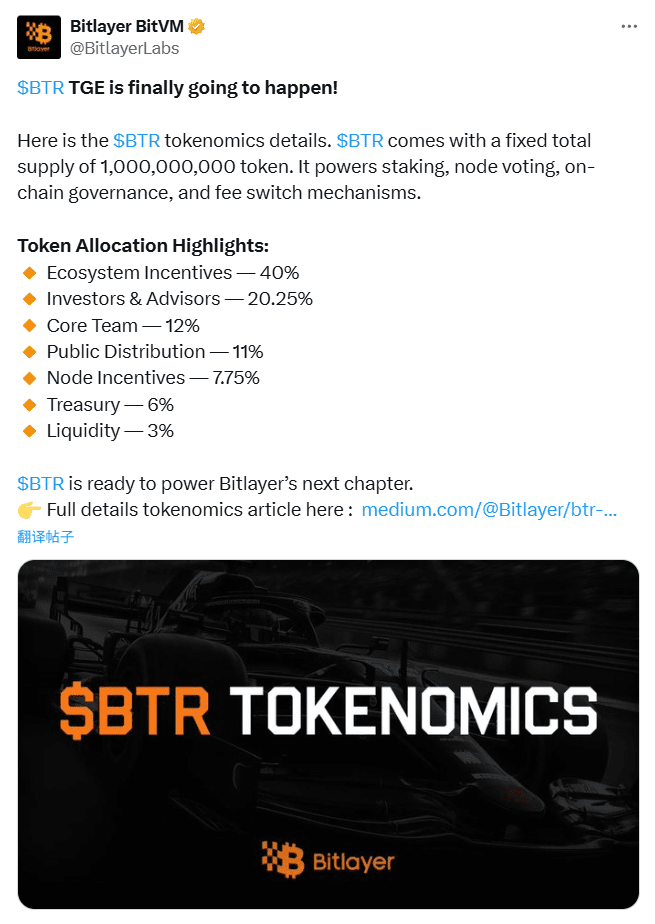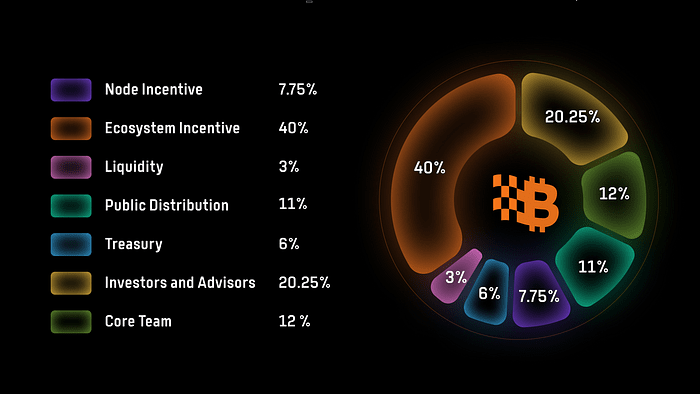Written by: Oliver, Mars Finance
When a star project - Bitlayer, crowned with the titles of 'first Layer 2 based on BitVM' and 'backed by Wall Street giant Franklin Templeton', officially announces its token $BTR is about to TGE, the market's sentiment is complex and divided. On one hand, there is the expectation brought by top capital endorsements and grand technological narratives; on the other hand, after experiencing the peak and subsequent decline of the inscription craze with countless 'meme L2' projects scattered, the entire market is permeated with fatigue and skepticism.

This raises a sharp question that everyone wants to know the answer to: Is Bitlayer issuing tokens now to take advantage of the remaining warmth of the Bitcoin ecosystem to complete a round of exquisite 'harvesting', or does it truly have the capability and capital to sound the new bull market's charge for this seemingly dormant ecosystem?
To answer this question, we must go beyond the superficial noise and delve into its technical core, strategic blueprint, and even the thoughts of its co-founder Kevin He - an entrepreneur who has experienced multiple bull and bear markets and has created a hundred billion TVL ecosystem, whose vision may provide us with key clues.
Bitlayer's three trump cards - technology, economic model, and execution capability
Bitlayer is not a reckless speculative project; its core competitiveness consists of three closely interconnected trump cards: solid technology, clear economic model, and reliable execution capability.
Technical trump card: The security narrative based on BitVM. Its core lies in the innovative application of the BitVM paradigm, returning to the essence of security. Co-founder Kevin He pointed out that BitVM is essentially based on optimistic rollups for Bitcoin, with the brilliance lying in the community consensus gradually shifting from the difficult attempt to build complex virtual machines on Bitcoin to a feasible path of directly verifying zero-knowledge proofs (ZK Proof). This means challengers only need to verify a deterministic ZK proof on the Bitcoin mainnet to adjudicate fraudulent behavior. This shift greatly reduces the difficulty of implementation and brings two fundamental advantages: it can be realized based on existing technologies like Taproot without requiring any upgrades to the Bitcoin protocol; at the same time, through on-chain verification, it firmly anchors the security of Layer 2 on the Bitcoin mainnet, breaking the traditional dilemma between security and programmability in scaling solutions. As the industry's first team to explicitly develop bridges and Layer 2 based on BitVM, Bitlayer has reached strategic cooperation with mainstream mining pools such as AntPool and F2Pool, obtaining nearly 40% of Bitcoin's hash power support, ensuring that in the event of a fraudulent challenge, challenging transactions can be prioritized for on-chain packaging - a core advantage that is hard for other teams to match.
Economic model trump card: meticulously designed $BTR token economics. This reflects not only its strategic intent but also a clear path from 'market dream rate' to 'price-earnings ratio'. The total supply of $BTR is fixed at 1 billion tokens, with a distribution strategy that clearly focuses on the long-term construction and incentives of the ecosystem.
Huge ecological incentives: up to 40% of tokens are designated for ecological incentives. This is a massive 'war fund', indicating that Bitlayer plans to invest substantial resources to guide and nurture its ecosystem to attract developers and users in the fiercely competitive L2 market.
Clear token utility: $BTR is endowed with multiple core functions, including staking to maintain network security, participating in on-chain governance decisions for the protocol's future, and a crucial fee switch mechanism. This mechanism can be used in the future to reward stakers or repurchase and destroy a portion of the protocol's revenue, directly linking token value to network economic activities.

Execution capability trump card: An experienced team and top capital. A grand vision ultimately requires a capable team to realize it. Kevin He's resume itself is a strong credential: he once led a team to create a high point of four million daily transactions and a TVL exceeding ten billion dollars for the HECO ecosystem. This mature team of nearly sixty people, led by him, along with endorsements from top capitals such as Framework Ventures, ABCDE Capital, and Franklin Templeton, together form a solid foundation for Bitlayer to turn its blueprint into reality.
The battlefield beneath the grand narrative - the true temperature of the Bitcoin ecosystem.
Bitlayer's ambitions need to be tested on a real battlefield. This battlefield - the Bitcoin ecosystem, is in a 'sage time' after a carnival, but far from silent. It presents a complex, multi-layered picture, with ice and fire coexisting.
As Kevin He has observed, there is a significant temperature difference in the perception of the ecological status between Eastern and Western markets. The Chinese community feels generally pessimistic after the early high expectations for the inscription craze have receded; meanwhile, the European and American markets remain quite active. He believes that judging BTC's performance cannot simply apply Ethereum's standards. The uniqueness of the BTC ecosystem lies in its massive financial activities, such as lending and derivatives trading, which have long existed off-chain. The real opportunity lies in securely and efficiently migrating these trillions of dollars worth of off-chain activities onto the chain. This is the vast ocean of BTCFi, and the current bottleneck is the lack of infrastructure.
Although the craze for inscriptions and runes has cooled, it has left two valuable legacies as a successful 'stress test': it has validated demand with real money, proving the market's immense desire to issue and trade assets on Bitcoin; at the same time, it has also exposed bottlenecks, making everyone realize that Layer 2 is essential for ecological development.
Therefore, during the market's cooling period, the true builders have not stopped, and an intense 'infrastructure race' is quietly unfolding on multiple fronts.
At the protocol layer, innovation is still deepening. After a two-year wait, the RGB protocol has finally gone live on the mainnet, representing the exploration direction of native smart contracts. The BRC 2.0 upgrade attempts to graft EVM compatibility onto the massive BRC-20 assets. In addition, native protocols like SAT 20, which have insisted on building for two years, have finally launched on the mainnet SatoshiNet.
At the application and infrastructure layer, competition is similarly fierce. Various Layer 2 solutions are accelerating delivery. Besides Bitlayer, the Bitcoin bridge Fiamma, built on BitVM 2, has also gone live on the mainnet, joining the competition for trust-minimized cross-chain solutions. Meanwhile, native L2s like Spark, which focus on payments and settlements, are continuously advancing.
At the asset and market level, the ecosystem is not completely frozen. The old Bitcoin NFT series led by 'Node Monkeys' NodeMonkes has shown strong signs of recovery recently. In the rune field, although the leader $DOG has performed mediocrely, several runes have excelled over a longer time dimension, and $DOG's successful listing on mainstream exchanges like Kraken marks a gradual recognition of rune assets.
In summary, the current Bitcoin ecosystem is not silent but has entered a stage of discerning the fake from the real and honing internal skills. Bitlayer is entering under such a backdrop where builders are competing with its unique technological route and strong capital.
Is it harvesting or dawn? The answer lies in the details of execution.
Now, we can more clearly answer the initial question. Is Bitlayer here to 'harvest'? Such risks do exist. BitVM is a cutting-edge and extremely complex technology, facing enormous technical execution risks. At the same time, with competitors like Merlin Chain seizing massive TVL through aggressive airdrops, market competition is exceptionally fierce.
However, the possibility of Bitlayer becoming a 'new hope' is becoming increasingly clear. This hope is no longer based on a vague dream but is built on a series of solid pillars:
A clear roadmap: It has a clear plan from market validation to secure implementation and constructing a high-frequency trading environment.
Pragmatic business model: It chooses to start from the interest needs of service institutions and users, rather than creating demand out of thin air.
Reliable leadership: It is steered by a seasoned leader, providing assurance for the project's execution capability.
Security philosophy aligned with Bitcoin's spirit: Its extreme pursuit of trust minimization is most likely to win the final trust of the core Bitcoin community and long-term holders.
$BTR's issuance is not the end of the story, but the starting gun. The massive 40% ecological incentive fund will be the fuel for Bitlayer to realize its three-phase roadmap. The ultimate answer lies not in the price of the coin at the moment of TGE, but in whether Bitlayer can reliably deliver on its technical commitments and effectively utilize this 'war fund' to cultivate a truly prosperous ecosystem that can transfer off-chain value of Bitcoin onto the chain.
For us observers, Bitlayer's journey will serve as the best sample to assess whether the Bitcoin ecosystem can complete the thrilling leap from 'digital gold' to 'programmable financial infrastructure'.

